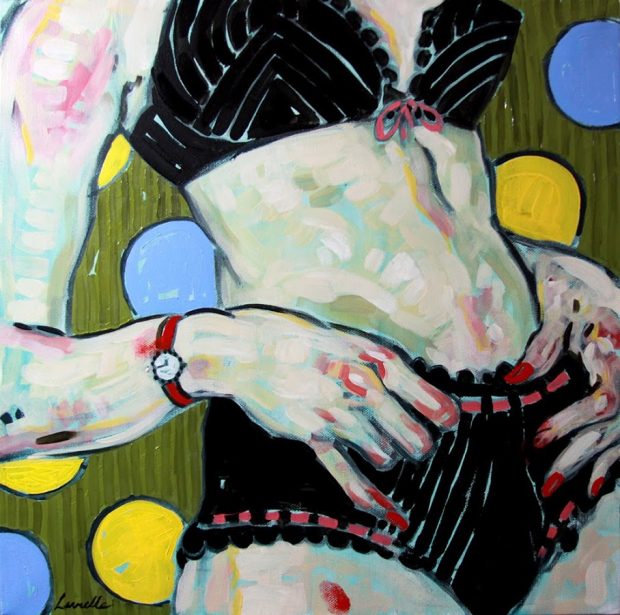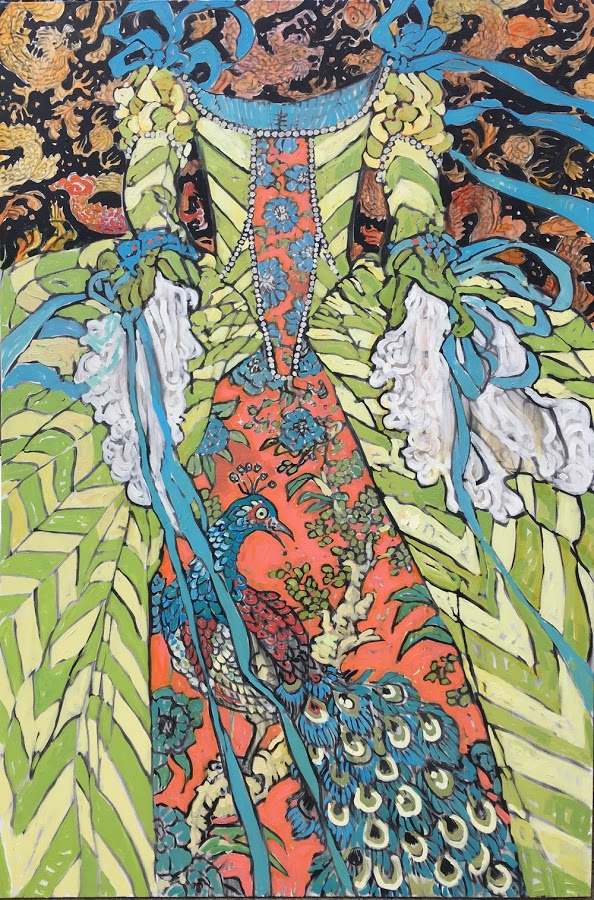
Artist REBECCA LEVEILLE sits down with our Editor KATARINA DJORIC For an exclusive interview to talk about moving on from fame found in illustration to a new career as a painter, pop culture and the message behind her art.
What are the first images that have marked your childhood?
I loved drawing Wonder Woman! Still love her.
What were your first art experiences?
My mom was an artist and taught me a lot at an early age. I’ve been drawing with passion since kindergarten.
When did you start painting?
Probably in Junior High.
And what about illustration?
I spent many years in Illustration and was very well known there under the name Rebecca Guay. I’ve been a guest at events all over the world because of it. I’m grateful for many aspects of that life, but there are limitations to the work that are inherent within the practice of illustration as a job. It was those limitations on the content of the work that led me to focus exclusively on gallery work over the last seven years. When you choose to grow a new skin in a new world, you have to accept that you may have to start at the beginning again. When I first started to build my gallery CV I had to, and was advised to, scrub my past in illustration from my CV. My illustration work is in major illustration museums but no one in the art world would care about that and I might have even hurt my chances of being taken seriously I kept it there. I had to go from people waiting in rope lines in Japan, in events named after me, to meet me and get my autograph, no joke, to absolutely nobody knowing me whatsoever. Walter Robinson told me I was “tired of winning”. It’s only now after being in many groups shows, some with significant jurors like Jane Panetta from the Whitney, and having some solo shows that I can now actually open up and include my illustration past in the dialogue. I often pull and reference my own pop culture past now within the dialogue of the work.


What kind of impact do you want to make with your art? What is the message?
There are many layers to the work.I want to represent something that feels like a personal internal truth. I’m the product pop culture. I’m a child of Barbie, and Bond Girls, and Wonder Woman and Patty Smith, and Annie Lennox. I love stilettos and combat boots, and am a complex and potent mass of conflict from all these things. We all are, and women particularly carry their own burdens here. I also feel it is deeply important to examine complex interpretations of the female gaze. For a thousand years – from Titian to Currin – all of culture has digested the female nude – the odalisque is a very sexualized very male thing that women have been asked to find beautiful, and personally I always have.
However culturally, it is so deeply rooted that I often see the expression of feminist art revolving again around the sexualized female form or vagina focused work. I have no issue with that of course, but I feel there are other things a woman artist can say with power and grace within that dialogue that is different imagery. I choose to use the sexualized male forms for this purpose in my work – I’m also deliberately painting male figures that are iconic and not connected to reality – they are male “odalisques” seen through a female gaze.
This is much of what my upcoming “End of Love” exhibition at the Untitled Space is about.

How does the path from an idea to a final art piece look like for you?
Because I do my best work when I’m always working-when I get ideas in the middle of one painting I quickly jot thumbnail notes on post its, sketchbooks, the wall, whatever is in close reach so I remember them and can start some of them after current paintings are finished.
Then its just nuts and bolts. I draw on a treated, sanded gesso, canvas in powdered graphite and water with a brush, seal it with matte medium then work in oil paint to finish.
Tell me more about your exhibition at the Untitled Space gallery?
I am very happy to have the new work showing here in a place that champions women artists. “The End of Love” exhibition will open May 1st and run until May 13th. It’s exciting as while I’ve had a solo show in LA, this is my first solo show in Manhattan.

How important is narrative for you?
Narrative is a tool I deliberately lean into. But my narrative is not literal and does not refer to secondary text- but reflects internal intentions. Narrative imagery along with figuration are having something of a rebirth in the art world. I look at artists Walton Fords, Kerry James Marshall, and Kara Walter and i feel inspired with how the tools of narrative and can be powerfully employed. This is the manner in the tradition that I aim to use the element of narrative.
How do you see the primary role of an artist in today’s society?
I think the artists role varies from discipline to discipline. All I know is what I want to give to culture and society my self. I have hope that the themes I address will affect people in a personal way.
Do you view the disposable aspect of social media as positive or negative in regards to your artwork?
Socials play an interesting role. They have opened up a great deal on many levels. People have access and are more aware of art – but they also make it so we get used to experiencing art in little digital boxes rather than being in the presence of the work in real space- and that is a loss.


Which artist would you say has influenced your artwork?
So many! Waterhouse, Lautrec, Michelangelo, Camille Claudel, Romaine Brooks, Walter Robinson, Inka Essenhigh, John Currin, Gerda Wegener, Kerry James Marshall.
Do you draw inspiration from other art forms such as film, music or literature?
Absolutely everything all the time – I draw inspiration from plastic water bottles, and shoes and, social media and random people on the street, and faces everywhere!
What work of art do you wish you owned?
Anything by any of the artists listed above!
Where do you see your art in the coming years?
Oh man. I want always to work with people who understand and nurture the work. I just want to paint and keep getting the work out there.
For more of Rebecca’s work visit rleveille.com.

Interview originally published in DESIGN SCENE May 2018 Issue 023, available now in print & digital.



















